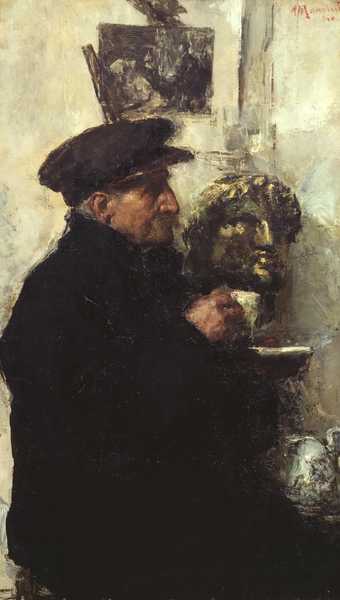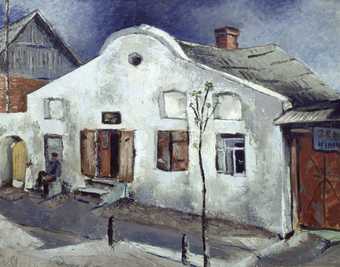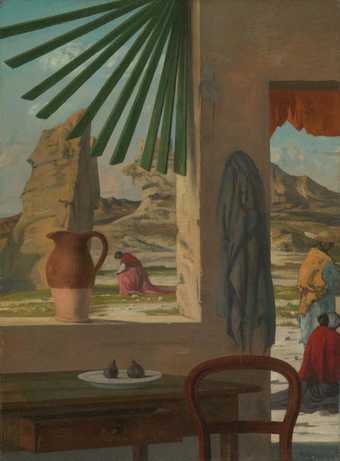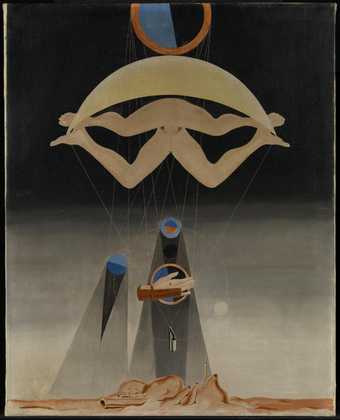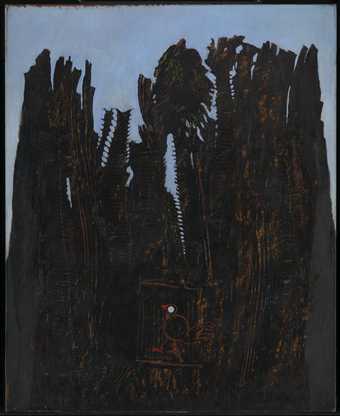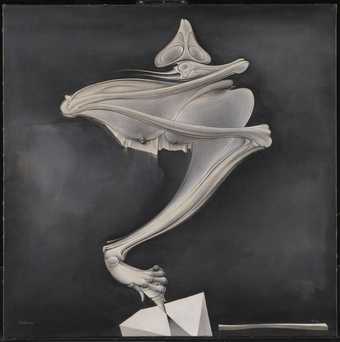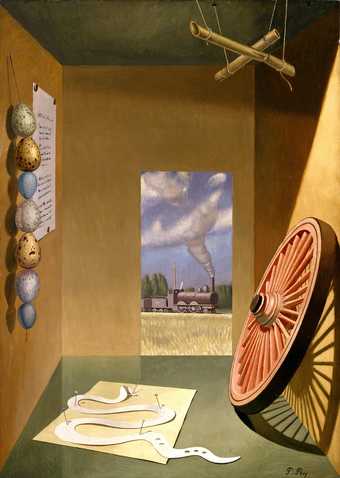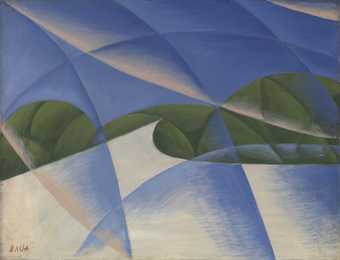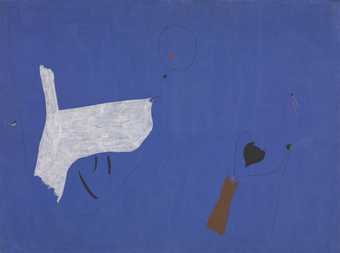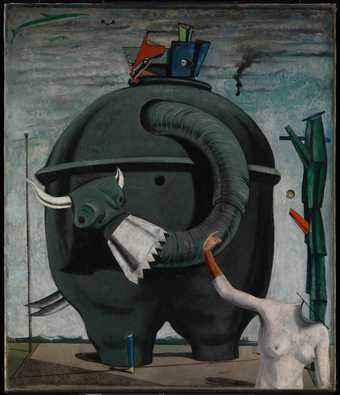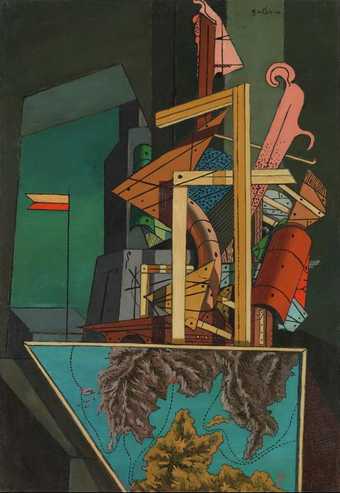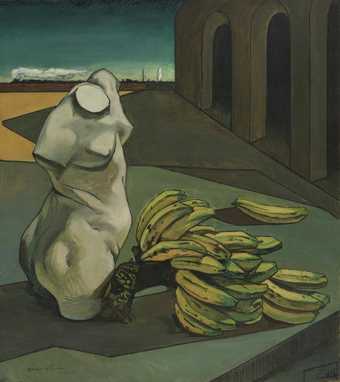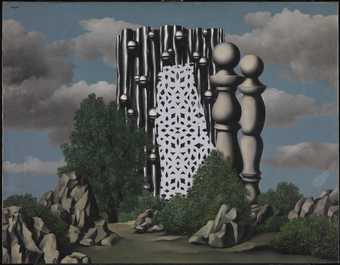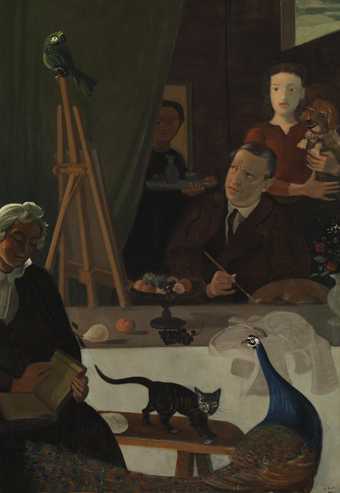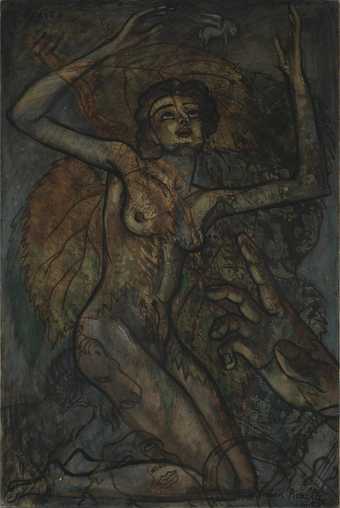
Not on display
- Artist
- Giorgio de Chirico 1888–1978
- Original title
- La Famille du peintre
- Medium
- Oil paint on canvas
- Dimensions
- Support: 1464 × 1149 mm
frame: 1630 × 1320 × 80 mm - Collection
- Tate
- Acquisition
- Purchased 1951
- Reference
- N05976
Display caption
In the mid-1920s de Chirico reworked many of the themes of his pre-war paintings in the light of his interest in the art of the old masters. In contrast to their pre-war counterparts, the mannequins in this work have a flesh-like solidity, while their grouping echoes traditional scenes of the Holy Family. The easel and painting stick appear to refer to the artist's belief in the importance of old-fashioned technical skills. However, de Chirico's attitude towards tradition and the past was always ambiguous and ironic. The building fragments that emerge from the mannequins' stomachs, for example, seem vaguely classical but also suggest a child's building blocks.
Gallery label, August 2004
Does this text contain inaccurate information or language that you feel we should improve or change? We would like to hear from you.
Catalogue entry
Giorgio de Chirico 1888-1978
N05976 La Famille du Peintre (The Painter's Family) 1926
Inscribed 'G. de Chirico' t.r.
Oil on canvas, 57 5/8 x 45 1/4 (146.5 x 115)
Purchased from Princess A.M. Callimachi (Knapping Fund) 1951
Prov:
With Léonce Rosenberg (Galerie de l'Effort Moderne), Paris (purchased from the artist); with Valentine Gallery, New York; with Pierre Matisse, New York, 1931; Arthur Jeffress, New York and London, 1936; Princess A.M. Callimachi, Egerton, 1946
Exh:
French Pictures from the Collection of Mr Arthur Jeffress, Southampton Art Gallery, August-September 1946 (15); Giorgio de Chirico, Palazzo Reale, Milan, April-May 1970 (75, repr.)
Lit:
James Thrall Soby, Giorgio de Chirico (New York 1955), pp.97, 161; Claudio Bruni, Catalogo Generale Giorgio de Chirico. Volume primo: Opere dal 1908 al 1930 (Milan c.1971), No.68, repr.
Repr:
Bulletin de 'L'Effort Moderne', No.31, 1927, between pp.8 and 9; Boris Ternovetz, Giorgio de Chirico (Milan 1928), 21st pl.
Painted in Paris in 1926. 'The Painter's Family' dates from de Chirico's period of association with the Surrealists when he tended to revive the subjects of his earlier Metaphysical period - in this case the mannequin figures - but in a heavier, more antique manner. The mannequin theme is said to have been inspired by a play Les Chants de la Mi-Mort
written by de Chirico's brother Andrea (Alberto Savinio) and published in Apollinaire's magazine Les Soirées de Paris
for July-August 1914. The drama's protagonist is a 'man without voice, without eyes or face'.
The artist wrote of this painting (letter of 21 July 1958): 'The idea of these large heads shaped like an egg, which one also sees in my standing mannequins of the metaphysical type, did in fact come to me from seeing the maquettes designed by my brother who used the pseudonym of Alberto Savinio. My brother who was a writer, musician and painter, had written in 1914 a play entitled Les Chants de la Mi-Mort. This play was published in a revue edited then by Guillaume Apollinaire. My brother's works influenced in France, Guillaume Apollinaire, Jean Cocteau and also certain aspects of the work of Picasso. ...
'In the Tate Gallery painting, the idea of these seated figures with a very developed bust and very short legs came to me on seeing certain Gothic figures (apostles and saints) which are seated.'
The device of a painting-within-the-painting likewise made its first appearance in de Chirico's work of 1914. The picture on the easel has some general resemblance to the main composition in reverse, but does not appear to be directly related to any other painting.
Published in:
Ronald Alley, Catalogue of the Tate Gallery's Collection of Modern Art other than Works by British Artists, Tate Gallery and Sotheby Parke-Bernet, London 1981, pp.121-2, reproduced p.121
Explore
- abstraction(8,615)
-
- from recognisable sources(3,634)
- features(8,872)
- fine arts and music(3,982)
- building blocks(4)
- mannequin(52)
You might like
-
Antonio Mancini Portrait of the Artist’s Father
c.1903–4 -
Niklavs Strunke The Town of Kraslava
1937–8 -
Eugène Berman The Jug on the Window
1934 -
Max Ernst Men Shall Know Nothing of This
1923 -
Max Ernst Forest and Dove
1927 -
Hans Bellmer Peg-Top
c.1937–52 -
Pierre Roy A Naturalist’s Study
1928 -
Giacomo Balla Abstract Speed - The Car has Passed
1913 -
Joan Miró Painting
1927 -
Max Ernst Celebes
1921 -
Giorgio de Chirico The Melancholy of Departure
1916 -
Giorgio de Chirico The Uncertainty of the Poet
1913 -
René Magritte The Annunciation
1930 -
André Derain The Painter and his Family
c.1939 -
Francis Picabia Otaïti
1930

